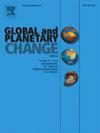foF2长期电离层趋势分析的信号分解技术
IF 4
1区 地球科学
Q1 GEOGRAPHY, PHYSICAL
引用次数: 0
摘要
利用经验模态分解(EMD)、黄土季节和趋势分解(STL)、奇异谱分析(SSA)和傅立叶变换(FT)四种信号分解技术对电离层长期趋势进行估计。这是这些技术第一次被用于估计电离层的趋势。将结果与经典的双步线性回归方法(最常用的从电离层过滤太阳影响的方法)和大气环流模型进行了比较。由于年平均电离层数据与太阳EUV指标具有很强的线性相关性,我们分析了1976-2022年期间9个台站的电离层数据在无线电波长上的5个太阳通量指数。分解模型可以在每个时间序列上独立使用,以过滤周期性和趋势。使用线性回归将代用物缩放到电离层数据范围,并减去残差以估计趋势。利用太阳通量F15计算的结果与大气环流模式预测的趋势吻合较好,前者为0.7% / a年,后者为- 0.8% / a年,后者为- 0.5% / a年;大多数模型和代理结果为负平均趋势。F10.7的变化趋势低于预期,SSA和STL的变化趋势约为- 0.2% / 10年,FT的变化趋势约为- 0.1% / 10年。在测试的方法中,FT的结果最一致。CEEMDAN也可以估计出可靠的结果,但只有在以相同的步骤过滤太阳和电离层数据的情况下。这项工作证明了新技术如何能够补充对高层大气长期趋势的研究。虽然最近的研究已经确定F30太阳通量是趋势估计最合适的代理,但我们的分析表明,它始终产生比预期更强的负趋势。相比之下,F15太阳通量,一个很少使用的指数,成为使用本工作中提出的方法的最可靠的代理。本文章由计算机程序翻译,如有差异,请以英文原文为准。
Signal decomposition techniques for foF2 long-term ionospheric trend analysis
Four signal decomposition techniques were applied to the problem of estimating ionospheric long-term trends: a variant of Empirical Mode Decomposition (EMD), Seasonal and Trend decomposition using Loess (STL), Singular Spectrum Analysis (SSA), and Fourier Transform (FT). This is the first time these techniques have been used to estimate ionospheric trends. The results were compared with the classic double-step linear regression method, the most used method to filter the solar influence from the ionospheric foF2, and with atmospheric general circulation models. Since yearly average ionospheric data exhibit strong linear correlation with solar EUV proxies, we analyze five solar flux indices at radio wavelengths alongside ionospheric data from 9 stations covering the period 1976–2022. The decomposition models can be used independently on every time series to filter periodicities and trends. The proxies are scaled to ionospheric data range using a linear regression, and the residuals are subtracted in order to estimate trends. The results using solar flux F15 are in good agreement with trends predicted by atmospheric circulation models of 0.7 %/decade, STL and SSA result in −0.8 %/decade, and FT in −0.5 %/decade; most models and proxies result in a negative averaged trend. F10.7 trends are lower than expected, about −0.2 %/decade for SSA and STL, and − 0.1 %/decade using FT. Among the tested methods, the FT provides the most consistent results. CEEMDAN can also estimate reliable results, but only when solar and ionospheric data are filtered in the same number of steps. This work demonstrates how novel techniques can complement the study of long-term trends in the upper atmosphere. While recent studies have identified the F30 solar flux as the most suitable proxy for trend estimation, our analysis reveals that it consistently produces stronger negative trends than expected. In contrast, the F15 solar flux, an index that is rarely used, emerges as the most reliable proxy using the methodology presented in this work.
求助全文
通过发布文献求助,成功后即可免费获取论文全文。
去求助
来源期刊

Global and Planetary Change
地学天文-地球科学综合
CiteScore
7.40
自引率
10.30%
发文量
226
审稿时长
63 days
期刊介绍:
The objective of the journal Global and Planetary Change is to provide a multi-disciplinary overview of the processes taking place in the Earth System and involved in planetary change over time. The journal focuses on records of the past and current state of the earth system, and future scenarios , and their link to global environmental change. Regional or process-oriented studies are welcome if they discuss global implications. Topics include, but are not limited to, changes in the dynamics and composition of the atmosphere, oceans and cryosphere, as well as climate change, sea level variation, observations/modelling of Earth processes from deep to (near-)surface and their coupling, global ecology, biogeography and the resilience/thresholds in ecosystems.
Key criteria for the consideration of manuscripts are (a) the relevance for the global scientific community and/or (b) the wider implications for global scale problems, preferably combined with (c) having a significance beyond a single discipline. A clear focus on key processes associated with planetary scale change is strongly encouraged.
Manuscripts can be submitted as either research contributions or as a review article. Every effort should be made towards the presentation of research outcomes in an understandable way for a broad readership.
 求助内容:
求助内容: 应助结果提醒方式:
应助结果提醒方式:


